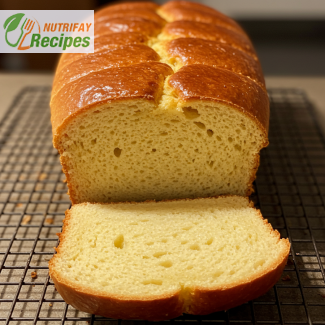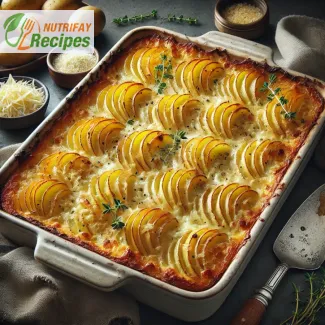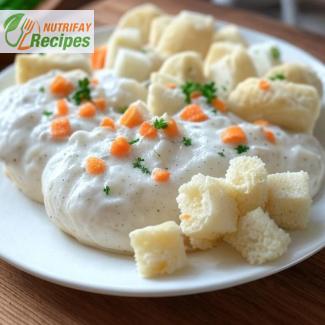When it comes to British culinary traditions, few dishes rival the comforting allure of a perfectly risen Yorkshire pudding. These golden, airy delights are not just a side dish; they’re a statement of tradition, flavor, and texture. Whether served alongside a hearty roast or enjoyed as a stand-alone treat, Yorkshire puddings never fail to impress. If you’ve ever wondered how to achieve that crispy exterior with a soft, tender center, this guide will take you through every step to master the art of making flawless Yorkshire pudding.
What Makes Yorkshire Pudding Irresistible?
The charm of Yorkshire pudding lies in its simplicity. Made from humble ingredients like eggs, milk, and flour, this dish transforms into a culinary masterpiece with the right technique. Its versatility is unmatched—perfect as a companion to roasted meats, a base for savory fillings, or even drizzled with a touch of syrup for a sweet twist. The contrast between the crisp outer layer and the airy, custard-like interior is a textural dream that captures the essence of comfort food.
Why You’ll Love This Recipe
- Foolproof Technique: Even if you’re a beginner, this recipe is designed to guide you step by step to perfection.
- Minimal Ingredients: With just a handful of pantry staples, you can create something extraordinary.
- Versatility: Yorkshire pudding isn’t just for Sunday roasts—it’s an ideal canvas for creativity in both savory and sweet applications.
- Crowd-Pleaser: Its golden beauty and tantalizing aroma make it a guaranteed hit at any table.
The Secret to Perfect Yorkshire Pudding
Achieving the perfect rise is every cook’s goal, and the key lies in three crucial elements:
- Preheated Fat: Starting with hot fat in your baking tin is essential. It ensures the batter starts cooking immediately, creating the signature puff and crispy edges.
- Rested Batter: Allowing the batter to rest before baking helps develop the gluten, resulting in a better rise and smoother texture.
- High Heat: A hot oven is your best ally for achieving that golden, puffed perfection.
A Dish Steeped in History
Originating in the Yorkshire region of England, this dish was historically served as a starter to fill up diners before the main course of meat. Over time, it has evolved into a staple of British cuisine, cherished for its adaptability and nostalgic charm. Whether you’re exploring its roots or crafting a modern twist, Yorkshire pudding holds a timeless appeal.
Tips for Success
- Use the Right Tin: A muffin tin or dedicated Yorkshire pudding tray works best for creating individual servings with even rises.
- Room-Temperature Ingredients: This helps the batter mix smoothly and rise consistently.
- Don’t Open the Oven Door: Resist the temptation to peek, as this can cause your puddings to deflate.
Bring Your Kitchen to Life with Yorkshire Pudding
Imagine serving a platter of golden Yorkshire puddings fresh from the oven. Their irresistible aroma fills your home, creating an atmosphere of warmth and indulgence. As your family and friends savor the crisp shell and soft center, you’ll know that you’ve mastered a dish that transcends time and tradition.
Ready to create the ultimate Yorkshire pudding experience? Follow this foolproof guide and watch your culinary confidence soar. With just a little effort, you’ll turn simple ingredients into a showstopping dish that’s as versatile as it is delicious.
Whether it’s for a holiday feast, a casual family dinner, or a creative dessert idea, Yorkshire pudding will always leave a lasting impression. Don't wait—your journey to mastering this classic starts today.
Prepare your ingredients and preheat your oven—it’s time to bring the magic of Yorkshire pudding to your table!
1. Prepare the Batter
- In a mixing bowl, whisk the eggs and milk together until smooth.
- Gradually sift in the flour and salt, whisking continuously to avoid lumps.
- Cover the batter and let it rest at room temperature for 30 minutes. Resting helps the gluten develop, ensuring a better rise and texture.
2. Preheat the Oven and Prepare the Tin
- Preheat your oven to 220°C (425°F).
- Place a small amount of oil or beef dripping into each cavity of a 12-hole muffin tin.
- Put the tin into the oven to heat the oil until it is very hot but not smoking. This should take around 5 minutes.
3. Bake the Yorkshire Puddings
- Remove the hot tin from the oven carefully.
- Quickly pour the batter into each cavity, filling them about two-thirds full. Work swiftly to prevent the tin from cooling.
- Return the tin to the oven and bake for 20 minutes without opening the oven door.
- The puddings should puff up beautifully and turn golden brown with a crisp exterior.
4. Serve Immediately
Yorkshire puddings are best served hot. Pair them with a roast dinner or use them to hold savory or sweet fillings.
Tips and Tricks to Perfect Yorkshire Pudding Every Time
Crafting the perfect Yorkshire pudding requires precision and understanding of how the ingredients and techniques influence the final result. Below, you'll find expert advice and insights to help you tweak and customize your recipe to suit your preferences while achieving consistently great results.
The Importance of Ingredients in Yorkshire Pudding
Eggs: The Backbone of the Batter
- Using large eggs provides the structure and rise for Yorkshire pudding.
- More eggs (e.g., 5 instead of 4) can result in a richer flavor and a slightly firmer texture, but overdoing it may make the puddings dense.
- Reducing eggs may yield a lighter pudding but can compromise stability, causing it to collapse faster after baking.
Milk: Creaminess and Texture
- Whole milk adds a creamy flavor and richness.
- For a lighter pudding, you can replace half the milk with water, but this might reduce the depth of flavor.
- Substituting milk with plant-based alternatives (e.g., almond or oat milk) can work for dairy-free versions, though it may alter the pudding’s rise and taste.
Flour: The Foundation of the Pudding
- Plain flour (all-purpose) is traditional and ensures a light texture.
- Using bread flour can make the puddings chewier due to its higher gluten content.
- A gluten-free blend works well for those avoiding gluten but requires a bit more resting time to allow the batter to hydrate fully.
Oil vs. Beef Dripping: Flavor and Texture
- Beef dripping adds a rich, savory depth that complements roasted meats.
- Vegetable oil is a neutral alternative that produces a lighter flavor, making it ideal for versatile puddings that can also pair with sweet fillings.
- Avoid using butter as it has a low smoke point, which can prevent proper rising.
Resting the Batter: Why It Matters
Letting the batter rest for at least 30 minutes is crucial for developing gluten, which contributes to the pudding's rise and texture.
- Longer resting times (up to 2 hours) may result in a better rise and smoother texture.
- Skipping the rest can lead to a less airy and uneven pudding.
Techniques to Achieve Perfect Yorkshire Pudding
Preheating the Tin
- A hot tin ensures the batter begins cooking instantly, creating a puffed structure.
- If the tin is not hot enough, the batter won’t rise properly, resulting in flat or soggy puddings.
Oven Temperature
- A high temperature of 220°C (425°F) is ideal for creating the signature rise.
- Lowering the temperature might produce softer puddings but sacrifices the crisp edges.
Pouring the Batter
- Pour the batter swiftly into the preheated tin to retain heat.
- Filling each cavity two-thirds full is optimal. Overfilling can cause uneven rising.
How Modifying the Recipe Affects Flavor
Adding Herbs and Spices
- Incorporating fresh thyme, rosemary, or chives into the batter gives a savory twist that complements roast dinners.
- For a sweeter version, add a pinch of cinnamon or nutmeg, pairing well with dessert fillings.
Using Alternative Fats
- Substituting vegetable oil with duck fat or goose fat provides a more luxurious flavor.
- For a vegetarian-friendly option, use coconut oil, but be mindful of its distinct taste.
Adding Cheese
- Mixing in grated Parmesan or cheddar results in a cheesy crust and deeper savory flavor.
How to Customize Yorkshire Puddings
Gluten-Free Options
Replace plain flour with a gluten-free all-purpose blend, but add an extra 5 minutes of resting time to allow the batter to hydrate fully.
Vegan Variations
- Replace eggs with aquafaba (chickpea water) or a chia seed slurry (1 tbsp chia seeds + 3 tbsp water per egg).
- Use plant-based milk and a neutral oil instead of traditional fats.
Sweet Yorkshire Puddings
- Add 1 tbsp sugar to the batter for a lightly sweetened version.
- Serve with whipped cream, fresh berries, or a drizzle of maple syrup for a dessert-inspired twist.
Common Issues and How to Solve Them
Flat Puddings
- Ensure the tin is properly preheated before pouring in the batter.
- Don’t open the oven door during cooking, as the drop in temperature can cause collapse.
Soggy Bottoms
- Use a metal tin rather than silicone for better heat distribution.
- Cook for an additional 3–5 minutes if the bottoms are undercooked.
Uneven Rising
- Make sure the batter is evenly mixed and free of lumps.
- Place the tin on the middle shelf of the oven for even heat distribution.
Experimenting with Fillings
Yorkshire puddings are incredibly versatile and can be filled with a variety of ingredients for a unique twist.
Savory Fillings
- Roast beef and gravy for a classic combination.
- Pulled pork and coleslaw for a modern take.
- Creamed mushrooms or spinach and feta for a vegetarian option.
Sweet Fillings
- Custard and fresh fruit for a dessert version.
- Chocolate ganache with a sprinkle of sea salt.
- Caramelized apples for a seasonal treat.
How These Changes Impact the Final Dish
- Adjusting the fat alters the depth of flavor and richness.
- Changing the flour or resting time influences the texture and rise.
- Sweet or savory additions create a whole new flavor profile, making Yorkshire puddings adaptable for any occasion.
By understanding the science and artistry behind this iconic dish, you can confidently adapt the recipe to suit your preferences, dietary needs, or creative inspirations. Experiment boldly, and discover the endless possibilities of Yorkshire pudding!
This recipe contains:
- Gluten (flour)
- Eggs (common allergen)
Substitutions to Make It Allergy-Friendly
- Gluten-Free Alternative: Replace plain flour with a gluten-free all-purpose blend.
- Egg-Free Option: Use a commercial egg replacer or a mixture of chia/flaxseed and water (1 tbsp seed + 3 tbsp water per egg).
- Vitamin B12: 0.2 µg – Supports nerve function and red blood cell formation.
- Calcium: 25 mg – Essential for healthy bones and teeth.
- Iron: 0.6 mg – Aids in oxygen transport in the blood.
- Potassium: 40 mg – Helps maintain fluid balance and proper muscle function.
- Vitamin E: 0.3 mg – Protects cells from oxidative stress.
- Carotenoids: Trace amounts – Beneficial for eye health.
The antioxidants in this dish are minimal due to the ingredients used but can be complemented with a side of roasted vegetables for added nutritional benefits.
Enjoy these golden, fluffy Yorkshire puddings fresh from the oven, and explore endless pairing possibilities!







